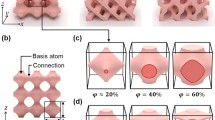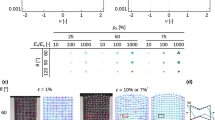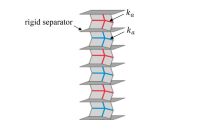Abstract
Analytical modeling is conducted to examine the quasistatic response of Miura-ori-based metamaterials under compression in two principal directions. For the \(x_{3}\) direction (out-of-plane) compression, the analytical results agree well with experiments and finite-element (FE) simulations. For compression in the \(x_{1}\) direction (in-plane), the analytical model can predict the initial force. Additionally, the strain-hardening effect of the cell wall material of Miura-ori metamaterial is also taken into consideration, and verified by the FE simulations. The ratio of the two forces corresponding to compression in the two respective directions is also obtained, offering a convenient way of assessing material properties. The energy absorption efficiency in different directions is compared. This study demonstrates that the performance of origami metamaterials can be tuned merely by changing the geometric parameters of the origami unit. The work should also provide theoretical guidance for designing metamaterials at small-scale unit cells.








Similar content being viewed by others
References
K. Miura, Zeta-core sandwich- its concept and realization (University of Tokyo, Tokyo, 1972), pp 137–164.
L.J. Gibson, and M.F. Ashby, Cellular solids: structure and properties (Cambridge University Press, Cambridge, 1999), pp 1–3.
G. Lu, and T. Yu, Energy absorption of structures and materials (Woodhead Publishing Limited, Cambridge, 2003), pp 1–27.
X. Xiang, G. Lu, and Z. You, Thin-Walled Struct. 157, 107130. (2020).
J. Zhang, G. Lu, and Z. You, Composites, Part B 201, 108340. (2020).
Z. Song, T. Ma, R. Tang, Q. Cheng, X. Wang, D. Krishnaraju, R. Panat, C.K. Chan, H. Yu, and H. Jiang, Nat. Commun. 5, 3140. (2014).
J. Dai, and D. Caldwell, Trends Food Sci. Technol. 21, 153. (2010).
G.B. Chai, and S. Zhu, Proc. Inst. Mech. Eng. Part L. 225, 207. (2011).
W. Wu, and Z. You, Proc. R. Soc. A 466, 2155. (2010).
M. Schenk, and S.D. Guest, Proc. Natl. Acad. Sci. U. S. A. 110, 3276. (2013).
Y. Chen, R. Peng, and Z. You, Science 349, 396. (2015).
K. Miura and R.J. Lang, Origami 4, ed. R.J. Lang (US: CRC Press, 2009), p. 87
J. Zhang, D. Karagiozova, Z. You, Y. Chen, and G. Lu, Int. J. Mech. Sci. 153, 194. (2019).
D. Karagiozova, J. Zhang, G. Lu, and Z. You, Int. J. Impact Eng. 129, 80. (2019).
J. Zhang, D. Karagiozova, G. Lu, and P. Chen, Thin-Walled Struct. 159, 107285. (2021).
J. Ma, D. Hou, Y. Chen, and Z. You, Thin-Walled Struct. 100, 38. (2016).
L. Yuan, H. Shi, J. Ma, and Z. You, Thin-Walled Struct. 141, 435. (2019).
K. Yang, S. Xu, J. Shen, S. Zhou, and Y.M. Xie, Thin-Walled Struct. 103, 33. (2016).
S. Ming, Z. Song, T. Li, K. Du, C. Zhou, and B. Wang, Mater. Des. 192, 108725. (2020).
Y. Li, and Z. You, Int. J. Solids Struct. 169, 21. (2019).
A. Ajdari, H. Nayeb-Hashemi, and A. Vaziri, Int. J. Solids Struct. 48, 506. (2011).
X. Zhou, H. Wang, and Z. You, Thin-Walled Struct. 82, 296. (2014).
X. Xiang, Z. You, and G. Lu, Compos. Struct. 195, 359. (2018).
J.M. Gattas, and Z. You, Int. J. Impact Eng. 73, 15. (2014).
J. Gattas, and Z. You, Int. J. Solids Struct. 53, 80. (2015).
C. Zhou, B. Wang, J. Ma, and Z. You, Int. J. Mech. Sci. 118, 1. (2016).
A. Pydah, and R. Batra, Thin-Walled Struct. 115, 311. (2017).
S. Fischer, Thin-Walled Struct. 90, 31. (2015).
M. Schenk, S. Guest, and G. McShane, Int. J. Solids Struct. 51, 4196. (2014).
S. Heimbs, J. Cichosz, M. Klaus, S. Kilchert, and A. Johnson, Compos. Struct. 92, 1485. (2010).
J. Zhang, G. Lu, Y. Zhang, and Z. You, Int. J. Impact Eng. 156, 103925. (2021).
X. Xiang, W. Qiang, B. Hou, P. Tran, and G. Lu, Thin-Walled Struct. 157, 106993. (2020).
W.J. Stronge, and T. Yu, Dynamic models for structural plasticity (Springer, London, 2012), pp 2–28.
T. Yu, and L. Zhang, Plastic bending: theory and applications (World Scientific, Singapore, 1996), pp 11–20.
Acknowledgements
The authors thank the Australian Research Council for financial support through Discovery Grants (DP180102661) and the National Natural Science Foundation of China (Grant No. 11872125).
Author information
Authors and Affiliations
Corresponding author
Ethics declarations
Conflict of interest
The authors declare that they have no conflict of interest.
Additional information
Publisher's Note
Springer Nature remains neutral with regard to jurisdictional claims in published maps and institutional affiliations.
Appendices
Appendix
Force-displacement curve in elastic stage
To evaluate the elastic response of Miura-ori materials under compression, it is assumed that the elastic deformation of cell walls is localized in a limited zone with bending along creases; the arc length of this region is nt (t is the wall thickness and n is usually within the range of 2~5). When the dihedral angle \(\theta\) reaches a certain value \(\theta_{el}\), the bending moment is assumed to be equal to the fully plastic bending moment. \(\theta_{el}\) can be obtained as 34:
The radius R of this zone and its relationship with bending moment can be approximately expressed as:
where I is the second moment of inertia of the cross-section. Therefore, the elastic response can be determined.
Rights and permissions
About this article
Cite this article
Qiang, W., Zhang, J., Karagiozova, D. et al. Quasi-Static Energy Absorption of Miura-Ori Metamaterials. JOM 73, 4177–4187 (2021). https://doi.org/10.1007/s11837-021-04939-w
Received:
Accepted:
Published:
Issue Date:
DOI: https://doi.org/10.1007/s11837-021-04939-w




